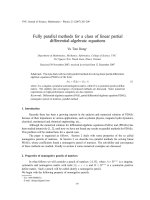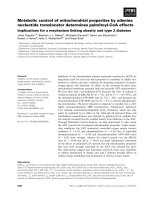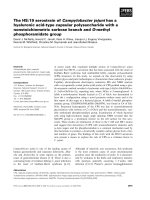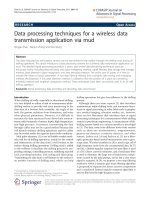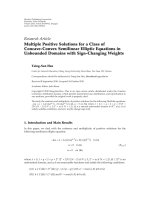POWER SERIES TECHNIQUES FOR A SPECIAL SCHRÖDINGER OPERATOR AND RELATED DIFFERENCE EQUATIONS MORITZ docx
Bạn đang xem bản rút gọn của tài liệu. Xem và tải ngay bản đầy đủ của tài liệu tại đây (519.23 KB, 10 trang )
POWER SERIES TECHNIQUES FOR A SPECIAL
SCHRÖDINGER OPERATOR AND RELATED
DIFFERENCE EQUATIONS
MORITZ SIMON AND ANDREAS RUFFING
Received 27 July 2004 and in revised form 16 February 2005
We address finding solutions y ∈ Ꮿ
2
(R
+
) of the special (linear) ordinary differential
equation xy
(x)+(ax
2
+ b)y
(x)+(cx + d)y(x) = 0forallx ∈ R
+
,wherea,b,c, d ∈ R
are constant parameters. This will be achieved in three special cases via separation and a
power series method which is specified using difference equation techniques. Moreover,
we will prove that our solutions are square integrable in a weig hted sense—the weight
function being similar to the Gaussian bell e
−x
2
in the scenario of Hermite polynomials.
Finally, we will discuss the physical relevance of our results, as the differential equation is
also related to basic problems in quantum mechanics.
1. Motivation via quantum mechanics
In quantum mechanics, when considering the two-dimensional hydrogen atom in a
strong magnetic field, one obtains the following ra dial Schr
¨
odinger equation for the “ra-
dial wave function” ψ of the electron:
ψ
(x)+
1
x
ψ
(x)+
E + mλ +
2Z
x
−
m
2
x
2
−
λ
2
4
x
2
ψ(x) =0 ∀x ∈R
+
. (1.1)
This equation is obtained by standard separation methods—decomposing the wave func-
tion into a radial and an angular part—as they are taught in every first course on quantum
mechanics, see for instance [5]. For a more analytic approach to the subject, see for in-
stance [4]. We briefly describe the motivation physicists gave us (cf. [2, 3]) to consider
further analytic properties of the differential equation (1.1).
In quantum physics, the problem of hydrogen atoms in strong magnetic fields has
a particular meaning: one motivation comes from experimental physics, that is, from
atomic spectroscopy—one would like to understand the spectra of highly excited hydro-
gen atoms in the so-called superstrong magnetic fields. But also in astrophysics, spectra
of hydrogen in strong magnetic fields play a role, for example, in the strongly magnetic
white dwarf stars. In all of these physically interesting situations, the mathematical mod-
els behind are related to the differential equation (1.1). We mention that the occurring
objects in (1.1) have the following interpretation in quantum mechanics.
Copyright © 2005 Hindawi Publishing Corporation
Advances in Difference Equations 2005:2 (2005) 109–118
DOI: 10.1155/ADE.2005.109
110 Power series techniques and Schr
¨
odinger operators
(i) x is the dimensionless radial distance (in the plane).
(ii) ψ gives information on the probability density for measuring a particle signal.
(iii) E is the dimensionless total energy.
(iv) m is the canonical angular momentum quantum number (integer!).
(v) Z is the integer multiple of the elementary charge e
0
of the nucleus.
(vi) λ is the dimensionless strength of the magnetic field.
Paying attention to the fact that the wave function ψ must yield a probability density |ψ|
2
,
we obtain the so-called Schr
¨
odinger boundary condition
∞
0
ψ(x)
2
xdx<∞. (1.2)
In [3], Robnik and Romanovski make use of the separation step
ψ(x) ≡x
|m|
e
−λx
2
/4
y(x). (1.3)
The above linear differential equation then reduces to
y
(x)+
2|m|+1
x
−λx
y
(x)+
E + λ
m −|m|−1
+
2Z
x
y(x) =0. (1.4)
Multiplying this equation by x results in a differential equation of the type
xy
(x)+
ax
2
+ b
y
(x)+(cx + d)y(x) =0 ∀x ∈ R
+
, (1.5)
where we used the abbreviations
a
=−λ, b =2|m|+1, c =E +λ
m −|m|−1
, d =2Z. (1.6)
Suppressing the arguments, (1.5) simply reads
xy
+
ax
2
+ b
y
+(cx + d)y =0. (1.7)
Motivated by (1.2), we furthermore want to see in which (weighted) sense the solutions
of (1.7) are square integrable.
2. Analytically solvable special cases
When trying to solve (1.7), we might first notice that we should rather appreciate a
second-order differential equation of the “Bessel-like” type
x
2
y
+ xy
+ p(x)y =0, (2.1)
where p(x)isapolynomialinx. But that is exactly what we obtain when we multiply
(1.1)byx
2
. Thus, our first step towards solving (1.7) is indeed to undo the separation
step made in [3]via
y(x) ≡x
(1−b)/2
e
−ax
2
/4
ψ(x) =x
−|m|
e
λx
2
/4
ψ(x), (2.2)
M. Simon and A. Ruffing 111
recovering the following Bessel-like equation for the wave function ψ:
x
2
ψ
+ xψ
+
−
a
2
4
x
4
+
c −
a(b +1)
2
x
2
+ dx −
(b −1)
2
4
ψ = 0. (2.3)
(In detail, (2.3) is either obtained by inserting the “undoing” step into (1.7)directly,or
by substituting a, b, c, d into (1.1)—multiplied by x
2
.) The polynomial p(x)in(2.1)is
now given by
p(x) =−
a
2
4
x
4
+
c −
a(b +1)
2
x
2
+ dx −
(b −1)
2
4
. (2.4)
Remark 2.1. At this point, one might suspect that the whole separation procedure was in
vain. Anyway, this is not totally true. The separation approach from [3]hasledusto(1.7),
which is of analytical interest. Working back the whole argumentation, we have found a
way to tackle this equation—by transforming it into (2.3).
In general, the polynomial p(x) is not of the form C
1
x
N
+ C
2
,whereN ∈ N and
C
1
,C
2
∈ R. However, this is the case in Bessel’s differential equation, which one can solve
analytically via power series techniques. We therefore consider the special cases where we
have
p(x) =C
1
x
N
+ C
2
, N ∈ N, C
1
,C
2
∈ R. (2.5)
Having a close look at the polynomial p(x)in(2.3) results in three such cases:
(i) a =c = 0 ⇒ p(x) ≡dx−B;
(ii) a =d = 0 ⇒ p(x) ≡cx
2
−B;
(iii) c =a(b +1)/2, d = 0 ⇒ p(x) =−Ax
4
−B.
Here we have made use of the abbreviations
A
≡
a
2
4
≥ 0, B ≡
(b −1)
2
4
≥ 0 (2.6)
for the sake of simplicity. In the next section, we are going to solve (2.3) in these three spe-
cial cases—the same as in Bessel’s case via power series. However, the analytically most
challenging and “new” case is (iii), since it conserves most of the structure of the gen-
eral differentialequation.Butwehavetokeepinmindthatallthespecialcasesnomore
depend on four parameters, but only on two of them. Physically speaking, we have “an-
nihilated” two degrees of freedom.
3. Power series and related difference equations
There is a quite general power series method for solving second-order differential equa-
tions of “Bessel-type” as discussed above; we refer for instance to [1]. We give an outline
of this technique.
Lemma 3.1. Let p
1
(x) =
∞
k=0
α
k
x
k
and let p
0
(x) =
∞
k=0
β
k
x
k
be convergent power series,
moreover let the differential equation
x
2
ψ
+ xp
1
(x) ψ
+ p
0
(x) ψ = 0 ∀x ∈Ᏸ (3.1)
112 Power series techniques and Schr
¨
odinger operators
begivenonsomedomainᏰ ⊂R.DenoteF(z) =z(z −1)+ α
0
z + β
0
.Ifasolutionof(3.1)is
of the form
ψ(x) =x
r
∞
n=0
η
n
x
n
∀x ∈Ᏸ, (3.2)
then there must exist F(r) =0. If, in addition, F(r + n) =0 for all n ∈N, then the coefficients
η
n
can be computed explicitly by the difference equation
η
n
F(r +n) =−
n
k=1
η
n−k
β
k
+ α
k
(r + n −k)
∀n ∈N, (3.3)
where η
0
∈ R is arbitrary. If the thus const ructed series in (3.2) converges, it indeed consti-
tutes a solution of (3.1).
Now we see more clearly why we wanted a differential equation like (2.1), just be-
ing a special case of (3.1). The crucial difficulty lies, of course, in solving the difference
equation (3.3). However, we are able to do this in our special cases (i)–(iii). What are the
coefficients α
k
and β
k
in the cases (i)–(iii)?
(i) α
0
= 1, α
k
= 0forallk ∈N,andβ
0
=−B, β
1
= d, β
k
= 0forallk ∈N \{1}.
(ii) α
0
= 1, α
k
= 0forallk ∈N,andβ
0
=−B, β
2
= c, β
k
= 0forallk ∈N \{2}.
(iii) α
0
= 1, α
k
= 0forallk ∈N,andβ
0
=−B, β
4
=−A, β
k
=0forallk ∈N \{4}.
Now, making the choice (3.2)fromLemma 3.1, all the cases yield the same relation for
the exponent r to be specified:
F(r)
= r(r −1)+r −B =r
2
−B
!
= 0. (3.4)
This equation leaves us with two choices for r,namely,
r
±
=±
√
B ≡±ρ. (3.5)
The result for F(r + n)wheren ∈ N is also the same, since the function F only depends
on the parameters α
0
and β
0
:
F(r +n) =(r + n)(r +n −1) + r +n−r
2
= 2rn+ n
2
= n(n +2r). (3.6)
The condition on r in order to guarantee F(r + n) =0foralln ∈ N thus reads −2r/∈ N.
Since we have by (3.5) the representation
r
±
=±ρ
!
=±
|b −1|
2
(3.7)
for the two possible values of r, we have to consider the cases b ≥1andb<1 separately.
Case 1 (b ≥ 1). We denote r
±
≡ r
1,2
.Herewehaveρ/2 = b −1, thus r
1
/2 = b −1and
r
2
/2 =1 −b.Hencer
1
≥ 0 satisfies the above condition, but r
2
satisfies it only if
b −1 /∈ N ⇐⇒ b/∈ N \{1}. (3.8)
M. Simon and A. Ruffing 113
Case 2 (b<1). We denote r
±
≡
˜
r
1,2
.Nowwehaveρ/2 =1−b, therefore
˜
r
1
/2 =1 −b and
˜
r
2
/2 =b −1. Thus
˜
r
1
> 0 satisfies the condition, whereas for
˜
r
2
, we must guarantee that
1 −b/∈ N ⇐⇒ b/∈ Z \N. (3.9)
Dropping the above separation, one easily notices that the corresponding “power series
solutions” ψ
1,2
will coincide in the case of convergence in the sense of the identities r
1
=
˜
r
2
and r
2
=
˜
r
1
. Therefore, the separation into the two different cases from above can be
avoided, combining the conditions (3.8)and(3.9) to the stronger condition
b/∈Z \{1}. (3.10)
If (3.10) is satisfied, the difference equation (3.3) will make sense for both r-values,
whereas it will only provide a sequence of coefficients η
n
for one of the r-values if (3.10)
is not fulfilled. (We will come back to the physical consequences later.)
Now the question arises whether the corresponding “solutions” ψ(x) = x
r
∞
n=0
η
n
x
n
of (2.3) are really solutions, that is, converge for every x ∈ R
+
. In the next theorem, we
are going to compute the coefficients explicitly, which allows us to prove this convergence
easily by the ratio test—not going into the details however. We rather state the result.
Theorem 3.2. If b/∈ Z \{±1},thedifferential equation (2.3) in each of the three cases men-
tioned above has a basis {ψ
1
,ψ
2
} of solutions of type (3.2), explicitly given by the following
representations.
(i) Special case 1 (a =c = 0, d =0):
ψ
1
(x) =x
(b−1)/2
∞
n=0
(−dx)
n
n
j=1
j( j +b −1)
, ψ
2
(x) =x
(1−b)/2
∞
n=0
(−dx)
n
n
j=1
j( j +1−b)
. (3.11)
(ii) Special case 2 (a =d =0, c =0):
ψ
1
(x) =x
(b−1)/2
∞
n=0
−cx
2
/2
n
n
j=1
j(2 j +b −1)
, ψ
2
(x) =x
(1−b)/2
∞
n=0
−cx
2
/2
n
n
j=1
j(2 j +1−b)
.
(3.12)
(iii) Special case 3 (a
= 0, c = a(b +1)/2, d =0):
ψ
1
(x) =x
(b−1)/2
∞
n=0
Ax
4
/4
n
n
j=1
j(4 j +b −1)
, ψ
2
(x) =x
(1−b)/2
∞
n=0
Ax
4
/4
n
n
j=1
j(4 j +1−b)
.
(3.13)
If otherwise b
∈ Z \{±1}, only one of those solutions of type (3.2) will exist.
Proof. We will only prove this for the “most interesting” case (iii). Consider 2r
1
= b −1
first. (Remember that we dropped the separation into b ≥1andb<1before!)ByLemma
3.1,wecanchooseη
0
arbitrarily, say η
0
≡ 1. The difference equation (3.3) then yields
114 Power series techniques and Schr
¨
odinger operators
η
1
= η
2
= η
3
= 0and
η
n
=
A
n(n + b −1)
η
n−4
∀n ≥4. (3.14)
Exploiting this recursion, we end up exactly with ψ
1
from the theorem. In t he same way,
we o btain ψ
2
when considering the other r-value, that is, 2r
2
= 1 − b.(Convergenceof
those series is—as was already mentioned—guaranteed by the ratio test.)
Corollary 3.3. In the case b/∈Z \{1},abasisofsolutionsof(1.7) is, in our three special
cases, given by
y
1,2
(x) ≡x
(1−b)/2
e
−ax
2
/4
ψ
1,2
(x) ∀x ∈ R
+
, (3.15)
where ψ
1,2
denote the solutions of (2.3)aswrittendowninTheorem 3.2.
We have a closer look at the functions y
1,2
in Cor ollary 3.3 at least in the case (iii).
They possess the explicit representation
y
1
(x) =e
−ax
2
/4
∞
n=0
ax
2
/4
2n
∞
j=1
j(4 j +b −1)
,
y
2
(x) =x
1−b
e
−ax
2
/4
∞
n=0
ax
2
/4
2n
∞
j=1
j(4 j +1−b)
.
(3.16)
It is a bit mysterious that the term ax
2
/4 appears both in the exponential function and in
the series. However, we have not found a suitable interpretation for this behavior. From
now on, we will be concerned with the weighted square integrability of our solutions.
Indeed, we will provide weight functions which allow such a scenario.
4. Square integrability with respect to Gaussian weights
We first have to specify what we understand by square integrability with respect to Gaussian
weights. This means for some solution y
∗
of (1.7) that there is a constant γ ≡ γ(a,b,c,d) >
0suchthat
∞
0
y
∗
(x)
2
e
−γx
2
dx < ∞. (4.1)
How this is related to (1.2) will be discussed in the last section. We provide an auxiliary
statement known from calculus.
Lemma 4.1. For arbitrary k>0 and l
≥ 0, the following “Gaussian” integrability condition
holds:
∞
0
x
l
e
−kx
2
dx < ∞. (4.2)
It is, for example, exploited in the context of Hermite polynomials.
Now we can state a quite general result concerning the existence of solutions y
∗
which
satisfy (4.1)forsomeγ>0.
M. Simon and A. Ruffing 115
Theorem 4.2. Provided that the condition (3.10) is satisfied, one obtains in the special cases
the following integrability situation:
(i) y
1
is square integrable with respect to a Gaussian weight if b ≥1/2;
(ii) y
1
is square integrable with respect to a Gaussian weight if b>0;
(iii) y
1
is square integrable with respect to a Gaussian weight if b>−1.
In all the cases, y
2
fulfills (4.1)forsomeγ>0 if b<−1.
Proof. We are going to prove the parts (i)–(iii) separately.
(i) Assume that b ≥1/2. We write down y
1
abitdifferently:
y
1
(x) =
∞
n=0
(−4dx)
n
n
j=1
4 j( j +b −1)
. (4.3)
Now we have for all j ∈ N,
4 j( j +b −1) ≥ 4j
j −
1
2
= 2j(2j −1), (4.4)
and therefore,
y
1
(x)
≤
∞
n=0
4|d|x
n
n
j=1
4 j( j +b −1)
≤
∞
n=0
4|d|x
n
(2n)!
∀x>0. (4.5)
Now fix x
0
= (4|d|)
−1
in order to obtain
4|d|x
n
≤
4|d|x
4n
=
16d
2
x
2
2n
≡
C
1
x
2
2n
∀x ≥x
0
, (4.6)
consequently,
y
1
(x)
≤ cosh
C
1
x
2
∀x ≥x
0
(4.7)
by the Taylor expansion of cosh. Moreover, we thus obtain the estimation
y
1
(x)
2
≤ cosh
2
C
1
x
2
=···=
1
4
e
2C
1
x
2
+2+e
−2C
1
x
2
∀x ≥x
0
. (4.8)
Finally, let γ ≡2C
1
+ ε,whereε>0 is arbitrary. Then we get with δ ≡ γ +2C
1
∞
x
0
y
1
(x)
2
e
−γx
2
dx ≤
1
4
∞
x
0
e
−εx
2
+ e
−γx
2
+ e
−δx
2
dx < ∞ (4.9)
by Lemma 4.1. This establishes the statement.
(ii) Assume that b>0. We again write down y
1
:
y
1
(x) =
∞
n=0
(−c)
n
x
2n
n
j=1
2 j(2 j +b −1)
. (4.10)
Once more, we obtain by the condition on b
2 j(2 j +b −1) ≥2j(2j −1) ∀j ∈ N. (4.11)
116 Power series techniques and Schr
¨
odinger operators
Performing the same estimation steps as above, now letting x
0
≡ c
−1/2
and C
2
≡
|c|,wegain
y
1
(x)
≤ cosh
C
2
x
2
∀x ≥x
0
. (4.12)
The remainder of the argumentation is left to the reader.
(iii) Now suppose b>−1. Then, slightly different to the par t s (i) and (ii), we obtain
y
1
(x)
=
y
1
(x) ≤e
−ax
2
/4
cosh
ax
2
4
∀x>0, (4.13)
and therefore,
y
1
(x)
2
≤
1
4
e
−ax
2
/2
e
ax
2
/4
+ e
−ax
2
/4
2
=
1
4
1+2e
−ax
2
/2
+ e
−ax
2
∀x>0. (4.14)
For a>0, the statement is hence an immediate consequence of Lemma 4.1.
Rather let a<0—as in the physical situation where a ≡−λ. Choosing γ ≡ ε −a
where ε>0 results in the same conclusion as in the previous cases, now letting
δ ≡ γ + a/2 > 0.
Having shown the part of the theorem concerned with y
1
, we now arrive w ith the state-
ment concerning y
2
. In each case, we define the function z : R
+
→ R via z(x) =x
b−1
y
2
(x).
Assume throug hout that b<−1. It is clear from the first part of the proof that z is square
integrable with respect to some Gaussian weight—taking over the role of y
1
. Indeed, for
some fixed x
0
> 0andγ>0, the integral
∞
x
0
|z(x)|
2
e
−γx
2
dx can be estimated from above
by a linear combination of “Gaussian” integrals
∞
0
e
−kx
2
dx,wherek>0. But now we have
y
2
(x)
2
= x
2(1−b)
z(x)
2
∀x>0, (4.15)
yielding the claim by Lemma 4.1, since l ≡ 2(1 −b) > 0.
Especially, in the important case (iii), Theorem 4.2 provides a one-dimensional sub-
space of solutions satisfying (4.1)forsomeγ>0, wh enever the condition (3.10) is guar-
anteed. The question is what happens if b ∈Z \{1}.
Case 1 (b>1). Then the solution y
1
in Corollary 3.3 exists, whereas y
2
does not. But
during the proof of Theorem 4.2, we have formally shown that y
1
satisfies (4.1)forsome
γ>0evenifb>−1. Therefore, y
1
is also square integrable in our weig hted sense in this
integer case.
Case 2 (b<1). T his time y
2
exists, not y
1
. And we know that y
2
fulfills our integrability
condition if b ≤−1—having a closer look at the last part of the preceding proof. Thus
we do not know what happens in the case b = 0, but can guarantee that y
2
satisfies the
condition if b<0.
Proposition 4.3. In the case 2c = a(b +1), a,b = 0, d = 0, a one-dimensional subspace
of solutions y
∗
is obtained—being of type (3.2)—which satisfies the integrability condition
(4.1)forsomeγ>0. On the one hand, if b ≥−1, this subspace is spanned by y
1
.Onthe
other hand, if b<−1, it is spanned by y
2
.
M. Simon and A. Ruffing 117
Remark 4.4. Similar statements hold in the cases (i) and (ii). But we will not go into
further details here, leaving them to the reader.
Last but not least, we have to come back to the physical motivation—having been a
starting point for the analysis of our special differential equation.
5. Physical interpretation and perspectives
Although the cases (i) and (ii) are of mathematical i nterest, we rather concentrate on a
discussion of the physical relevance of the solutions established in case (iii). What is the
meaning of the parameters a, b, c, d in quantum mechanics?
(a) a =−λ stands for the strength of the magnetic field. Since a is arbitrar y in our
consideration, we cover a lot of physical scenarios from this viewpoint.
(b) b = 2|m|+ 1 corresponds to a quantum number. In the physical setting, we can
only have b ∈ N. In t his integer case, we only obtain one (linearly independent)
power series solution like (3.2), namely, y
1
. However, this solution satisfies (4.1)
for some γ>0byProposition 4.3.
(c) c = E −a(m + |m|−b) is related to quantum numbers (energy and angular mo-
mentum) and to the magnetic field. Here we have 2c =a(b +1), and therefore,
2E =a
2m +2|m|−b +1
!
⇐⇒ E =−λm. (5.1)
The requirement (5.1) means that the energy in our case must be quantized by in-
teger multiples of the magnetic field strength—after having chosen suitable units.
(d) d
= 2Z is twice the number of the protons in the nucleus. However, the restriction
d = 0 is quite unfortunate, since it says that there are no protons in the nucleus.
Hence we are somehow treating the case of a free electron.
The inter pretations (a)–(d) show that the scenario we addressed in (iii) is not the “typi-
cal” physical scenario, nevertheless it is interesting for quantum mechanics because of the
energy quantization in (c). Maybe something similar can be obtained if d
=0—probably
via perturbation methods. (One has to take into consideration that, in a strong magnetic
field, one can sort of neglect the influence of the Coulomb forces.)
We finally pay attention to our integrability condition, in comparison to (1.2). By the
relation
y
1
(x) =x
−|m|
e
λx
2
/4
ψ
1
(x), (5.2)
the condition (4.1) is equivalent to the following condition for the “wave function”:
∞
0
ψ
1
(x)
2
x
−2|m|
e
(λ/2−γ)x
2
dx < ∞. (5.3)
Comparing (5.3)and(1.2), we see that the Schr
¨
odinger boundary condition (square in-
tegrability of the wave function) is satisfied if, for some x
0
> 0, the estimation
x
≤ const·x
−2|m|
e
(λ/2−γ)x
2
∀x>x
0
(5.4)
118 Power series techniques and Schr
¨
odinger operators
holds true. For m = 0, this is clearly equivalent to 2γ<λ. But in step (iii) of the proof
of Theorem 4.2,wehadchosenγ>λ, not being compatible with the above assert ion.
Therefore, we cannot guarantee the Schr
¨
odinger boundary condition via our estimations
from above.
The very last problem immediately leads us to a question for possible future research
on the topic: can one weaken the assertion γ>λsuch that it is possible to have 2γ<
λ—at least for certain magnetic fields? Another weak point is that physicists are mainly
interested in wave functions which can be decomposed into some ground state times a
polynomial, preferably yielding a sequence of orthogonal functions when considering all
quantizations. In our approach, we did not get polynomials, but just power series—being
quite similar to Bessel functions. Can we ameliorate this scenario? And at last, how can
we get rid of the unnatural assertion d = 0, forcing the nucleus to be uncharged? A lot of
work has to be done in approaching these questions from a purely analytical viewpoint.
Acknowledgments
The authors gratefully appreciate the support from the Grant AbiTUMath 2001, more-
over the inspiring atmosphere of the European Advanced Studies Conference 2001, and
the Undergraduate Research Symposium at the Castle of Oto
ˇ
cec, Slovenia.
References
[1] M. Brokate, Analysis 4, preprint, 2001, Lectures at Munich University of Technology.
[2] M. Robnik and V. G. Romanovski, Atoms in strong magnetic fields: some new analytic results,
Nonlinear Phenom. Complex Syst. 5 (2002), no. 4, 445–456.
[3]
, Two-dimensional hydrogen atom in a strong magnetic field,J.Phys.A36 (2003), no. 29,
7923–7951.
[4] A. Ruffing, Mathematical methods in quantum mechanics, preprint, 2001, Lectures at Munich
University of Technology.
[5] F. Schwabl, Quantenmechanik, 6th ed., Springer, Berlin, 2002 (German).
Moritz Simon: Department of Mathematics, Centre for Mathematical Sciences, Munich University
of Technology, Boltzmannstrasse 3, 85747 Garching, Germany
E-mail address:
Andreas Ruffing: Department of Mathematics, Centre for Mathematical Sciences, Munich Univer-
sity of Technology, Boltzmannstrasse 3, 85747 Garching, Germany
E-mail address: ruffi
